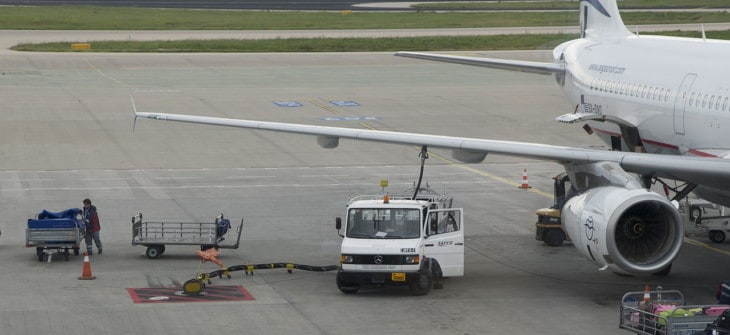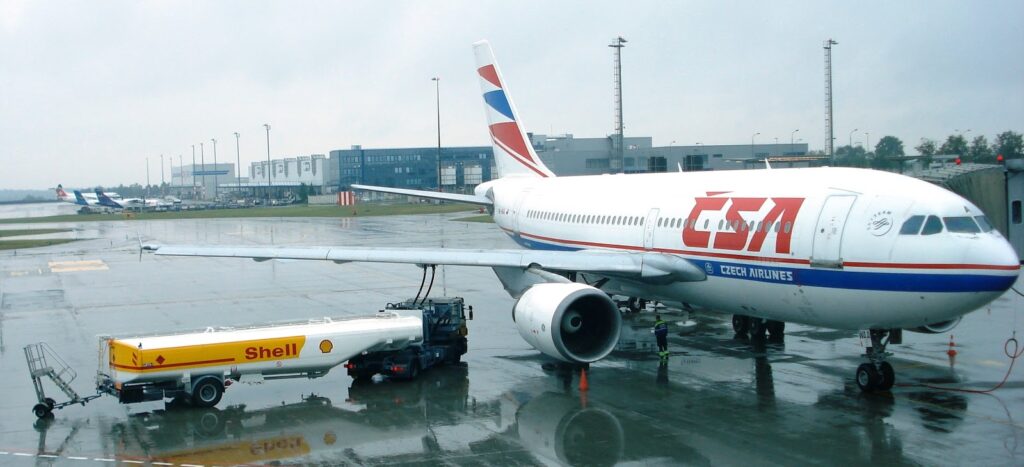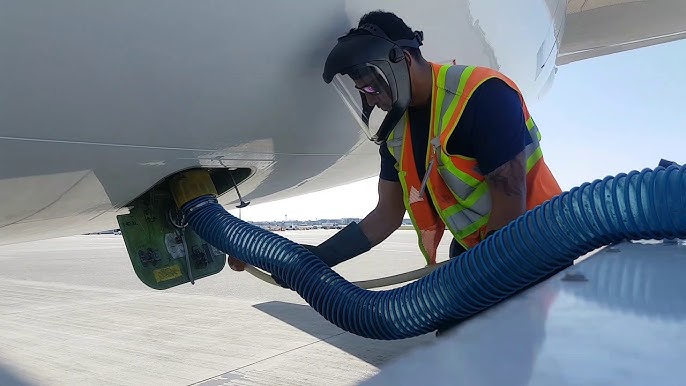Fuel is typically stored in dedicated fuel tanks located within the wings and sometimes in the fuselage of an airplane. The wings of most commercial airplanes are designed with compartments specifically engineered to contain fuel. These compartments are divided into multiple sections, each serving as a fuel tank.
The specific design and placement of fuel tanks can vary depending on the type and size of the aircraft. Larger aircraft may have multiple fuel tanks distributed across the wings and fuselage, while smaller planes might have their fuel stored mainly in wing tanks.
The strategic placement of fuel tanks in the wings helps maintain stability and balance during flight. Additionally, modern aircraft are designed with safety measures to prevent fuel leaks and to protect the tanks from damage in the event of an emergency.
What are the primary areas for aircraft fuel storage?

The allocation and location of fuel storage within aircraft are carefully planned to ensure optimal performance, safety, and efficiency based on the specific requirements and design considerations of each aircraft model.
Primary Areas for Fuel Storage
Wings
Design and Structure: Aircraft wings commonly house dedicated compartments or tanks specifically engineered for fuel storage. These wing tanks vary in size and shape based on the aircraft model and are strategically placed within the wingspan.
Advantages: Storing fuel in wings provides several advantages such as optimizing the aircraft’s center of gravity, aiding in flight stability, and efficiently utilizing available space without intruding into the passenger or cargo areas.
Safety Considerations: Wing fuel tanks are designed with safety features to prevent leaks, minimize risks of fuel ignition, and protect the tanks from damage during flight or emergency situations.
Fuselage
Instances of Fuselage Fuel Storage: In certain aircraft configurations, particularly smaller planes or those with specialized designs, fuel storage within the fuselage is employed. This setup involves integrating fuel tanks into the main body of the aircraft, often in spaces that might otherwise be utilized for passengers, cargo, or other equipment.
Reasons for Fuselage Fuel Storage: Fuselage-based fuel storage might be utilized to maintain balance, accommodate additional fuel requirements in smaller aircraft, or as part of the aircraft’s structural design in unique configurations.
Variations and Considerations: The use of fuselage storage can vary widely among different aircraft models, influenced by factors such as size, purpose, and design specifications.
Variations Based on Aircraft Type and Size
The placement and quantity of fuel storage areas vary significantly depending on the design and intended use of the aircraft. Larger commercial planes often have multiple wing tanks distributed along the wingspan, while smaller planes might rely on fewer or smaller tanks concentrated in specific areas.
Aircraft size directly impacts the quantity of fuel stored and the design of storage areas. Larger planes possess higher fuel capacities, requiring more extensive and distributed fuel tank systems compared to smaller aircraft.
The placement and distribution of fuel storage play a crucial role in maintaining the aircraft’s balance, stability, and overall performance during different phases of flight, including takeoff, cruising, and landing.
How are fuel tanks designed and located within aircraft wings?
Wing-based fuel storage is a fundamental aspect of aircraft design, offering structural efficiency, performance optimization, and stringent safety features to ensure safe and reliable operation throughout a flight.
Design and Structure of Wing Fuel Tanks
Wing fuel tanks are internally compartmentalized spaces within the aircraft wings, specially constructed to hold and distribute fuel efficiently. These tanks are designed with precision to maximize storage capacity while conforming to the aerodynamic shape of the wing.
The tanks are integrated into the wing structure, often utilizing reinforced materials to withstand various stresses encountered during flight, such as turbulence and structural loads. They are also equipped with internal baffles or partitions to minimize fuel movement and maintain stability.
Wing fuel tanks are equipped with pump systems that facilitate fuel transfer to the engines during flight. These systems manage fuel flow rates and maintain a consistent supply to the engines.
Purpose and Advantages of Storing Fuel in Wings
Placing fuel within the wings contributes to maintaining the aircraft’s center of gravity, crucial for stable flight characteristics. It helps in balancing the weight distribution, especially as fuel is consumed during the flight.
Storing fuel in the wings optimizes aerodynamics by utilizing the available wing space efficiently. This design choice minimizes interference with other aircraft components, allowing for better airflow and reduced drag.
Wings provide ample, designated space for fuel storage without encroaching on passenger or cargo areas, making them an ideal location for accommodating substantial fuel quantities.
Safety Features and Considerations for Wing-Based Fuel Storage
Wing fuel tanks are designed with multiple layers of safety measures to prevent fuel leaks or spillage. These safety features include durable tank materials, sealants, and monitoring systems to detect and contain leaks promptly.
To mitigate the risk of fire, wing tanks incorporate flame-retardant materials and inert gas systems that displace oxygen, reducing the potential for combustion.
Aircraft are equipped with emergency procedures for fuel-related contingencies, including fuel transfer anomalies, leaks, or potential system failures, ensuring safe handling and mitigation of risks.
What instances warrant fuel storage within the fuselage of an aircraft?
The choice between wing-based and fuselage-based fuel storage heavily depends on various factors such as aircraft size, design constraints, performance considerations, and specific operational needs, leading to diverse fuel storage configurations across different aircraft models.
Instances of Fuel Storage in the Fuselage
Fuselage-based fuel storage is observed in certain aircraft designs where wing space might be limited or where alternative fuel storage configurations are required. Smaller aircraft or those with unconventional designs sometimes utilize the fuselage for fuel storage.
In some instances, especially in smaller or specialized aircraft, fuel tanks are strategically positioned within the fuselage, occupying spaces that may not be utilized for passengers, cargo, or other critical systems.
Reasons for Storing Fuel in the Fuselage
Fuselage-based fuel storage can aid in maintaining the aircraft’s balance by distributing weight more evenly along its length, compensating for various factors like payload distribution or specific design requirements.
In aircraft with limited wing space or those with unique configurations that restrict wing-based fuel storage, storing fuel in the fuselage might be the most viable option.
Some specialized aircraft, such as certain military or experimental planes, might opt for fuselage-based fuel storage to accommodate mission-specific requirements or structural designs.
Differences in Fuel Storage Between Various Aircraft Models
Different aircraft models exhibit diverse approaches to fuel storage based on their intended use, size, and design philosophy. Larger commercial aircraft predominantly rely on wing-based storage due to its inherent advantages in balance, safety, and performance.
Smaller planes, including regional or private aircraft, might feature a wider array of fuel storage placements. While some may utilize wing-based storage akin to larger aircraft, others might opt for fuselage-based storage due to their smaller size and design limitations.
Certain specialized aircraft, like high-performance jets or experimental planes, might employ unconventional fuel storage methods, often dictated by their unique design and operational requirements.
How do different factors influence the location of fuel storage on planes?

Fuel storage locations on aircraft are intricately determined by a combination of design considerations, flight performance requirements, and safety protocols, all aimed at ensuring safe, efficient, and reliable operation throughout the aircraft’s lifecycle.
Aircraft Design Considerations
Aircraft designers prioritize aerodynamic efficiency, influencing fuel storage locations to minimize drag and optimize flight performance. Wing-mounted tanks are favored due to their ability to maintain streamlined shapes.
Designers ensure that fuel storage areas, whether in wings or fuselage, integrate seamlessly into the aircraft’s structure to maintain strength, rigidity, and overall integrity while considering weight distribution and stress factors during flight.
Variations in fuel storage locations are heavily influenced by the intended purpose of the aircraft. Commercial airliners prioritize passenger comfort, cargo space, and fuel efficiency, leading to predominantly wing-based fuel storage. Conversely, military or specialized aircraft may have diverse configurations to meet specific operational requirements.
Impact on Flight Performance and Balance
Fuel storage directly affects the center of gravity throughout the flight. Efficient placement of fuel ensures the aircraft’s stability, especially as fuel is consumed during flight, preventing potential imbalances that could compromise safety and performance.
The location of fuel tanks impacts an aircraft’s handling characteristics, affecting aspects like maneuverability, responsiveness, and stability during different flight phases, such as takeoff, cruising, and landing.
Fuel storage location influences the aircraft’s range and endurance. Optimal fuel distribution and storage enable longer flight durations without compromising safety or performance.
Safety and Emergency Protocols Related to Fuel Storage Placement
Aircraft are equipped with sophisticated systems to detect and prevent fuel leaks, including sensors, monitoring equipment, and robust tank design. Leak detection systems promptly identify any issues, allowing for immediate corrective actions.
Safety measures include fire suppression systems within fuel storage areas. These systems mitigate fire risks by using inert gasses or specialized extinguishing agents to prevent or contain combustion.
Pilots and crew undergo rigorous training on emergency protocols related to fuel-related contingencies. These procedures include managing fuel transfer anomalies, handling potential leaks, and safely managing fuel-related emergencies, ensuring passenger and crew safety.
FAQ’s
Where does a 747 hold its fuel?
A 747 typically holds its fuel in its wings.
Do planes fly with full fuel tanks?
Planes often do not take off with completely full fuel tanks to minimize weight and optimize efficiency.
Where are the fuel tanks on an A380?
Fuel tanks in an A380 are primarily located in the wings.
Can a plane destroy a tank?
Planes are not equipped to intentionally destroy tanks; their design focuses on safely storing fuel.
Do planes empty fuel before landing?
In emergency situations or when the aircraft exceeds its maximum landing weight, planes may dump fuel before landing.
What happens when a plane dumps fuel?
When a plane dumps fuel, it evaporates in the air or dissipates before reaching the ground, following safety procedures to minimize risks on the ground.
Final Words
So, where the plane keeps its fuel is super important for how it flies safely. Most planes stash fuel in their wings, which helps keep the plane steady and balanced while it’s up in the sky. Some planes, though, might store fuel inside the main body, called the fuselage, if they need to or if there’s not enough space in the wings. The size and job of the plane decide where the fuel goes.
This choice affects how the plane flies and deals with different situations. They’ve got safety plans in place, like ways to spot leaks and what to do in emergencies, to make sure everything stays safe. Making sure the fuel’s stored right keeps the plane safe and working well whenever it takes off.

